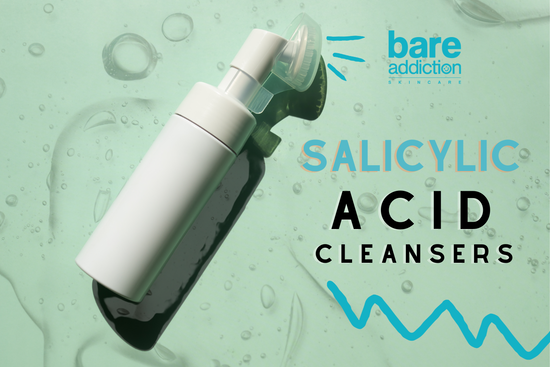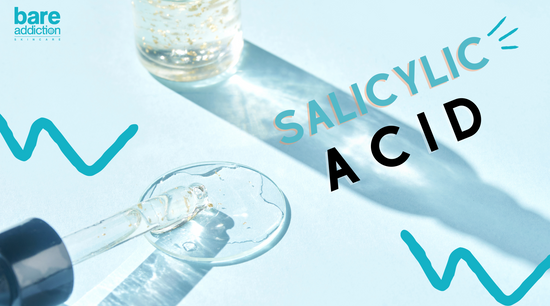Is Salicylic Acid Good for Skin? Unveiling Its Benefits and Use
Is Salicylic Acid good for skin?
Understanding Salicylic Acid and Its Impact on Skin Health
Is Salicylic acid good for skin? Well let's start with what it is. Salicylic acid is a renowned ingredient in the skincare world, celebrated for its profound impact on skin health. Originating from willow bark, this beta-hydroxy acid has transcended its natural roots to become a staple in modern dermatology, primarily due to its ability to penetrate deeply into the pores of the skin.
Commonly utilized in the formulation of various skincare products, salicylic acid is especially favoured for its exfoliating and anti-inflammatory properties. It works by dissolving the type of skin debris that clogs pores and causes acne, making it an excellent treatment for combating blackheads, whiteheads, and other forms of blemishes.
Its ability to reduce sebum secretion further endears it to those battling oily skin. Recognized not only for clearing acne but also for its potential to rejuvenate skin by promoting the shedding of old skin cells, salicylic acid is integral to preventive skincare routines aimed at maintaining clear and healthy skin. Its uses in dermatology extend beyond mere acne treatment, as it is also employed in products targeting psoriasis, calluses, and more, making it a versatile tool for skin maintenance and health.

Table of content
The Benefits of Salicylic Acid for Skin Care
Salicylic acid is highly valued in the skincare industry for its multifaceted benefits, particularly its prowess in managing and preventing acne. This beta-hydroxy acid excels primarily due to its exceptional exfoliating properties. By facilitating the removal of dead skin cells from the surface of the skin and within the pores, salicylic acid prevents the buildup that can lead to blockages and acne outbreaks. Its ability to penetrate deeply into the pores distinguishes it from other exfoliants, allowing it to dissolve the debris and sebum that often lead to blackheads and whiteheads.
For individuals with oily and acne-prone skin, salicylic acid offers additional advantages. Its keratolytic action helps thin the top layer of the skin, easing the removal of dead and damaged cells and promoting healthier skin growth beneath. This process not only clarifies the complexion but also reduces the likelihood of future acne flare-ups by keeping the pores clear of obstructive materials. Furthermore, salicylic acid is noted for its anti-inflammatory properties, which alleviate the redness and swelling associated with acne lesions, providing a calming effect on irritated skin.
Another significant benefit of salicylic acid is its role in acne prevention. By maintaining clear pores and minimising oiliness, it creates an unfriendly environment for acne-causing bacteria, which thrive in blocked, oily conditions. This preventative action helps reduce the frequency and severity of breakouts, contributing to a clearer, more balanced skin complexion.
Overall, salicylic acid's ability to exfoliate, clear pores, and prevent acne makes it an invaluable component in the skincare regimens of those dealing with oily and problematic skin types. Its wide-ranging benefits ensure that it remains a cornerstone ingredient for anyone seeking to improve their skin health and appearance significantly.
How Salicylic Acid Works to Improve Your Skin
Salicylic acid is renowned for its effective action against acne and its ability to enhance skin texture. It belongs to a class of drugs known as salicylates, which function by softening keratin, a protein that forms part of the skin structure. This softening helps to loosen dry, scaly skin, making it easier to shed. This process is known as keratolysis, which is pivotal in the treatment of acne by promoting the turnover of the outer layer of skin.
The keratolytic properties of salicylic acid facilitate the removal of the stratum corneum, the outermost layer of the skin. By doing so, salicylic acid not only prevents pores from becoming clogged but also aids in the removal of clogs that have already formed. This unclogging is crucial because it prevents the buildup of sebum and dead skin cells, which can lead to the formation of comedones, or acne lesions.
Moreover, salicylic acid’s ability to penetrate into the pores enhances its effectiveness. Once inside the pores, it helps to dissolve the debris that causes the pore to become blocked, such as excess oil and dead skin cells. This deep cleansing action reduces the likelihood of acne flare-ups and promotes a smoother, more even skin texture.
Additionally, salicylic acid has mild anti-inflammatory properties, which help reduce the redness and swelling often associated with acne breakouts. This makes it an ideal choice for those with acne-prone skin, as it not only helps to clear existing acne but also soothes the skin, reducing the visual impact of acne lesions.
In essence, salicylic acid works by promoting the exfoliation of the skin’s surface and deep cleaning the pores, a dual action that significantly aids in improving the health and appearance of the skin, particularly for those suffering from acne. This makes it a cornerstone ingredient in the fight against acne and in routine skincare for maintaining clear, healthy skin.
Incorporating Salicylic Acid into Your Skincare Routine
Incorporating salicylic acid into your daily skincare routine can significantly enhance your skin's clarity and texture, especially if you struggle with acne or oily skin. To achieve the best results while ensuring safety, it’s important to understand the types of products available and the optimal ways to apply them.
Firstly, salicylic acid is available in a variety of formulations, including cleansers, toners, spot treatments, and moisturizers. When starting with salicylic acid, it's wise to choose a product that suits your specific skin concerns. For general acne prevention and maintenance, a salicylic acid face wash can be used once or twice daily. These cleansers help remove excess oil and debris from the skin without the need for prolonged contact, which minimizes the risk of irritation.
For targeted application, consider using spot treatments or serums that contain higher concentrations of salicylic acid. These are designed to be applied directly to blemishes and can be more potent in combating stubborn acne. However, because of their strength, they should be used sparingly to avoid over-drying the skin.
When incorporating salicylic acid products into your routine, start slowly. Initially, apply salicylic acid every other day to monitor how your skin reacts, and gradually increase to daily use as your skin acclimates. This cautious approach helps mitigate potential side effects such as dryness or peeling.
It’s also crucial to balance your routine with hydrating and soothing products, especially if you have sensitive skin. Using a non-comedogenic moisturizer after applying salicylic acid will help maintain your skin’s hydration levels without clogging pores. Additionally, always apply a broad-spectrum sunscreen during the day, as salicylic acid can increase your skin's sensitivity to sunlight.
By choosing the right products and following these best practices for application, you can safely and effectively incorporate salicylic acid into your skincare regimen, ensuring your skin reaps all the benefits without adverse effects.
Is Salicylic Acid bad for skin?
Potential Side Effects of Salicylic Acid and How to Mitigate Them
Salicylic acid is renowned for its effectiveness in treating a variety of skin issues, particularly acne. However, like all active ingredients, it can have side effects, especially if used improperly or in too high concentrations. Commonly, users may experience dryness or irritation, particularly when they first begin using products containing salicylic acid. This is due to its keratolytic action, which can strip away oils along with dead skin cells.
To mitigate these effects, it's important to start with lower concentrations of salicylic acid, especially if you have sensitive skin. Products with 0.5% to 2% salicylic acid are generally sufficient for most skin types without causing excessive dryness or irritation. Additionally, integrating a salicylic acid product into your routine gradually can help your skin adjust. Begin by applying it every other day and observe how your skin reacts before using it daily.
Another crucial step is to bolster your skincare regimen with supportive care products. Hydrating moisturisers, particularly those containing ingredients like hyaluronic acid or ceramides, can help restore the skin’s moisture barrier. Using a gentle, non-comedogenic moisturiser after applying salicylic acid treatments will soothe and protect the skin, reducing potential irritation. Moreover, for daytime routines, always include a broad-spectrum sunscreen as salicylic acid can increase your skin's sensitivity to the sun, leading to quicker burns and damage.
By understanding these side effects and preparing to manage them with supportive skincare, you can enjoy the full benefits of salicylic acid without undue discomfort.
Comparing Salicylic Acid with Other Skincare Acids
Salicylic acid, glycolic acid, and lactic acid are powerhouses in the skincare world, each offering unique benefits depending on your skin type and concerns. Understanding the distinctions between these acids can help you tailor your skincare routine for optimal results.
Salicylic Acid : This beta-hydroxy acid (BHA) is oil-soluble, which allows it to penetrate deeply into the pores to dissolve the bonds that hold dead skin cells together. It is particularly effective for oily and acne-prone skin as it can clear clogged pores and reduce breakouts. Its anti-inflammatory properties also make it beneficial for those with rosacea or sensitive, acneic skin.
Glycolic Acid : As an alpha-hydroxy acid (AHA), glycolic acid is water-soluble and primarily works on the surface of the skin. It is known for its ability to exfoliate the skin, speed up cell turnover, and brighten the complexion. Glycolic acid is great for all skin types, particularly aging skin, as it helps to diminish fine lines, wrinkles, and hyperpigmentation. However, its intense exfoliation can sometimes be too harsh for very sensitive skin types.
Lactic Acid : Also an AHA, lactic acid is milder than glycolic acid, making it a better choice for sensitive or dry skin types. It helps to moisturize as well as exfoliate by increasing the skin’s natural barrier to hold in water. Lactic acid is excellent for those looking to improve skin texture and tone while gently removing dead skin cells.
While all three acids promote clearer, more youthful skin, their different properties cater to specific skincare needs. Salicylic acid is unmatched for deep pore cleansing, glycolic acid excels at comprehensive surface exfoliation, and lactic acid offers a gentle approach to enhancing skin hydration and softness.
Choosing between these acids depends largely on your skin type and the specific issues you want to address. It's also beneficial to note that using these acids in combination can sometimes offer synergistic effects, but it's important to do so cautiously to avoid skin irritation. As always, incorporating any new acid into your routine should begin with a patch test and perhaps a consultation with a dermatologist to ensure compatibility with your skin.
Conclusion: Is Salicylic Acid Right for You?
In this guide, we've explored the substantial benefits of salicylic acid, particularly its prowess in combating acne and revitalizing oily skin types through deep pore cleansing and inflammation reduction. Its versatility extends to treating a variety of skin issues, making it a staple in many skincare regimens. However, whether salicylic acid is suitable for you depends on your specific skin concerns and type. While it offers remarkable benefits for many, its intensity may not suit everyone, especially those with extremely sensitive skin. If you're considering integrating salicylic acid into your routine, consulting with a dermatologist is highly recommended. They can provide personalized advice and ensure that your skin care enhances your skin’s health without adverse effects. Embrace the potential of salicylic acid but proceed with informed caution to truly benefit from its skin-transforming capabilities.



